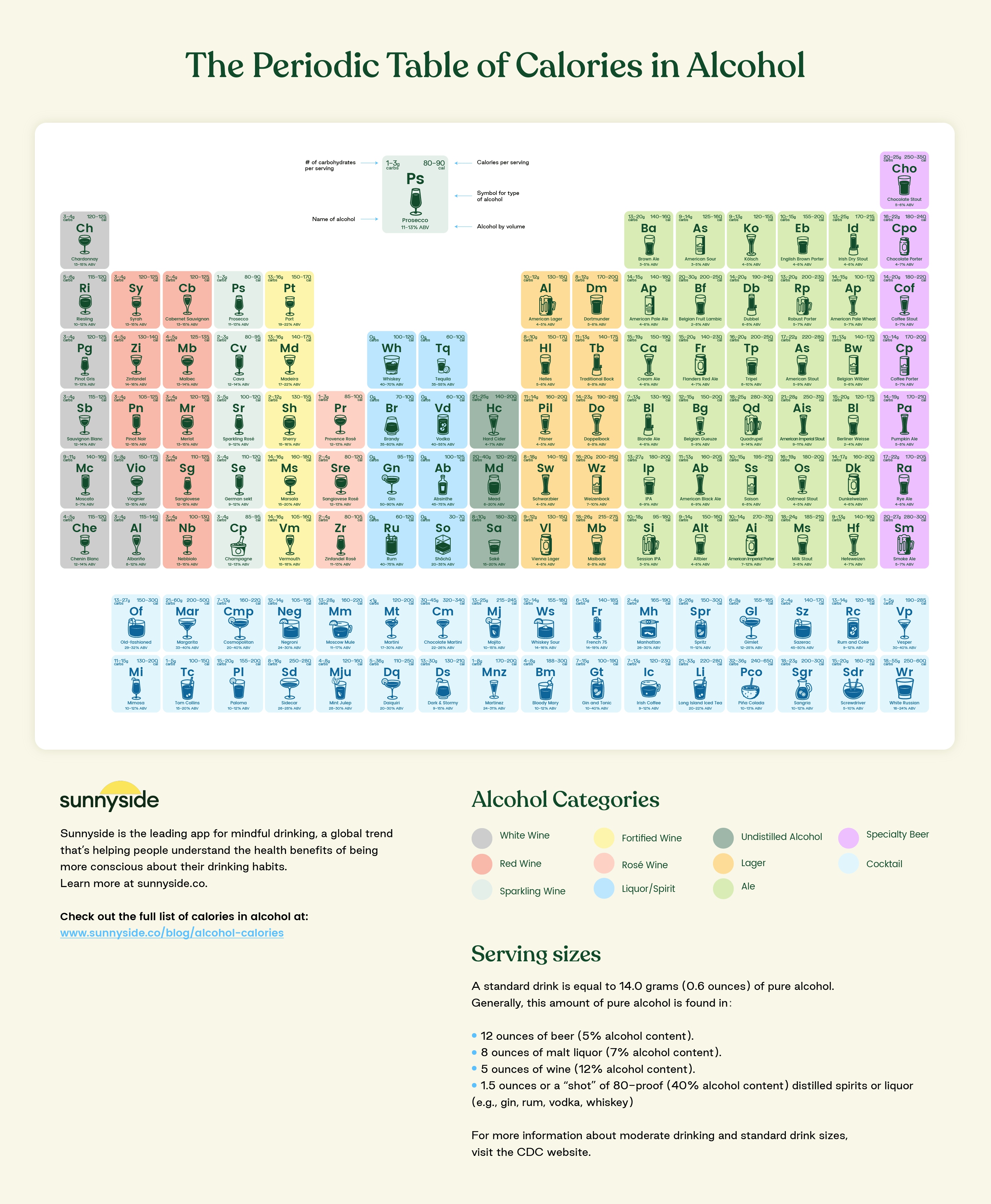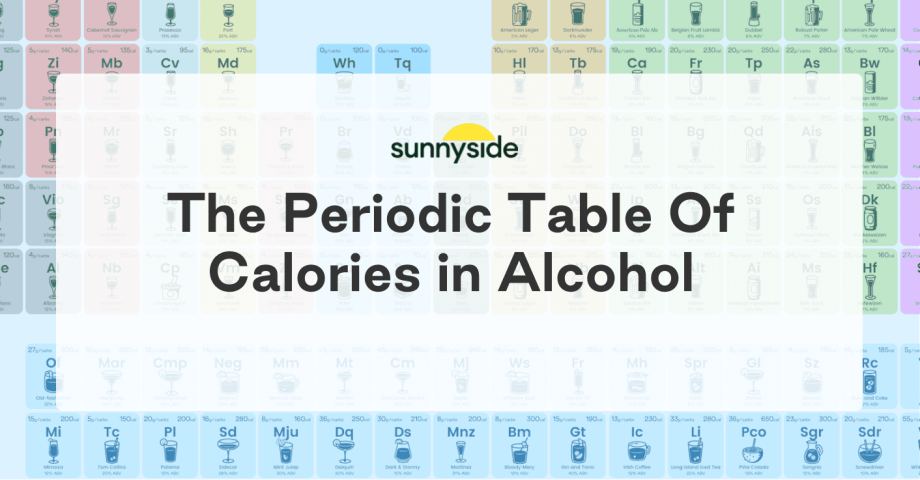Last Updated on July 13, 2023
If you’re sick of hangovers, post-alcohol crashes, and an expanding waistline, it may be time to practice mindful drinking. And no, this doesn’t mean you have to eliminate alcohol from your diet. In fact, some research has found that light and moderate drinking is unlikely to be associated with weight gain.
Instead, the focus lies on being mindful of how much you drink and understanding the carbs, calories, and alcohol content of your favorite beverages. Meaning, you don’t need to quit drinking entirely in order to cut back on the calories and draining effects of alcohol
To help you kickstart your mindful drinking journey, here’s a complete list of the ABV, carbs, and calorie content of 119 different alcoholic drinks. Find out how your favorite tipples stack up against other beverages, and feel free to bookmark this page for future reference!
The Periodic Table Of Booze
So how many calories are veiled behind an alcoholic drink?
Well, it depends on the type of alcohol, the amount of residual sugar from fermentation, and whether the drink contains added sugar or flavorings.
We’d like to introduce you to our periodic table of booze—a comprehensive depiction of the ABV and estimated number of calories and carbs per standard serving of 119 alcoholic beverages.
As per the CDC’s guidelines, a standard serving size is is equal to 14.0 grams (0.6 ounces) of pure alcohol. Generally, this amount of pure alcohol is found in:
- 12 ounces of beer (5% alcohol content).
- 8 ounces of malt liquor (7% alcohol content).
- 5 ounces of wine (12% alcohol content).
- 1.5 ounces or a “shot” of 80-proof (40% alcohol content) distilled spirits or liquor (e.g., gin, rum, vodka, whiskey).
Of course, these are estimates based on our research. The actual number of calories and carbs in a specific drink will differ from brand to brand. Click the image below to see the high-resolution version.

How Many Calories are in White Wine?
White wines are pale-colored wines made from green and yellow grapes, or black grapes that have had their skins removed. Here’s a list of the different white wine varieties and their respective ABV, carbs, and calories per serve.
Chardonnay
ABV: 13-15, Calories: 120-125, Carbs: 3-4
As the most popular white wine in the world, Chardonnay captures different tastes and flavors depending on its location and climate. Expect a citrusy, peachy, or apricot flavor in cooler regions, while warmer temperatures will give rise to more tropical notes like pineapple and mango.
Riesling
ABV: 10-12, Calories: 115-120, Carbs: 5-6
Think orchard fruits like apricot, apple, and pear. The characteristic lime notes, pronounced fruity flavors, and high acidity (similar to lemonade) give this almost-perfume wine an impressive aging potential.
Pinot Gris
ABV: 10-13, Calories: 120-125, Carbs: 3-4
Often overshadowed by other members of the Pinot family, Pinot Gris is a full-bodied wine with a refreshing and spicy flavor. It has low acidity and is high in sugar when fully ripened.
Sauvignon Blanc
ABV: 12-14, Calories: 115-125, Carbs: 3-4
Named based on the French words for “wild” (sauvage) and “white” (blanc), Sauvignon blanc is quite expressive of terroir. You can expect various flavors, mainly a combination of herbs and grasses with tropical fruits and pronounced acidity.
Moscato
ABV: 5-7, Calories: 140-160, Carbs: 9-11
Moscato is a sweet Italian wine famous for its delightful fruity notes—mandarin orange, nectarine, peach, and honeysuckle, to name a few. It has a relatively lower ABV but higher sugar content than other white wines.
Chenin Blanc
ABV: 12-14, Calories: 115-120, Carbs: 4-5
Chenin Blanc comes in numerous flavors, depending on the winemaking method utilized. Dry summer varieties typically have an apple, pear, or quince aroma, while sweeter styles show louder hints of ginger, marmalade, mango, and other tropical fruits.
Albariño
ABV: 8-12, Calories: 115-140, Carbs: 3-4
Primarily made in Spain’s Rías Baixas region, Albariño is a white wine with refreshing citrus notes and a sprinkle of salinity. This light-bodied and high-acidity wine pairs exceptionally well with seafood pasta, mussels, and other shellfish.
Viognier
ABV: 13-15, Calories: 150-175, Carbs: 5-8
With flavors ranging from delicate floral notes to creamy vanilla with spices and clove, Viognier is well-known as a bolder white wine variation with an oily sensation.

How Many Calories Are In Red Wine?
Made from the fermentation of dark-skin grapes, red wines are widely-adored for their rich flavors and texture. Generally speaking, they tend to have a higher calorific value than other wine types.
Pinot Noir
ABV: 12-15, Calories: 105-125, Carbs: 3-4
Pinot Noir is the world’s most celebrated red wine. This light-bodied wine has flavors of berries, mushrooms, and damp leaves.
Red Zinfandel
ABV: 14-16, Calories: 130-140, Carbs: 4-5
Red Zindafel is a bold wine that carries rich, jammy, and fruity flavors and a higher alcohol content than its white zin counterpart. You’ll also notice licorice, black pepper, or cinnamon notes intertwined with various oak intensities.
Syrah
ABV: 13-15, Calories: 120-125, Carbs: 3-4
As one of the world’s darkest and fullest-bodied red wines, Syrah has a rich and powerful punch of fruity flavors. In its youth, this wine has more floral-forward notes but reels in black pepper and herbaceous scents as it ages.
Cabernet Sauvignon
ABV: 13-15, Calories: 120-125, Carbs: 2-4
Cabernet Sauvignon takes on dark fruit flavors with a generous amount of tannin and notes of pepper, herbs, and leather. Its rich, classic flavors make it the perfect pairing for grilled meats and peppery sauces.
Malbec
ABV: 13-14, Calories: 125-135, Carbs: 4-5
Malbec wine has a gorgeous deep purple color, fruity flavors, and savory notes. Black cherry, chocolate, plum, coffee, leather, and tobacco are the range of notes this wine may hit.
Merlot
ABV: 13-15, Calories: 120-125, Carbs: 3-4
Mix fruity cherry flavors with a luxurious chocolatey finish, and you’ll get Merlot wine. Often mistaken for its cousin, Cabernet Sauvignon, Merlot wine has a fruitier and more delicate taste and goes well with burgers, steaks, and pizza.
Sangiovese
ABV: 12-15, Calories: 110-125, Carbs: 3-4
A medium-bodied, high-acid wine with medium to high tannins. This wine is a skilled shapeshifter, boasting different flavors and tastes —from strawberry and tart cherry to leather, smoke, and tobacco.
Nebbiolo
ABV: 13-15, Calories: 100-130, Carbs: 3-4
This full-bodied red has an aroma of roses, leather, and tar. It’s grown mainly in Italy’s Piedmont region and is commonly paired with Italian delicacies. It also goes well with steak and braised duck.




How Many Calories Are In Sparkling Wine
Alcohol, bubbles, and everything nice—and thus, the sparkling wine was born. These wines have a unique fizziness that differentiates them from other varieties. Also, they tend to sit on the lower-calorie end of the spectrum.
Prosecco
ABV: 11-13, Calories: 80-90, Carbs: 1-3
The Prosecco is an Italian sparkling wine with carbonation that lasts longer than beer but not usually as long as Champagne. Most are produced in a brut and dry style, containing around 1.5g of sugar per standard glass.
Cava
ABV: 12-14, Calories: 80-95, Carbs: 2-3
This Spanish sparkling wine is made from a mix of different grapes to create a balanced fruity blend. Most Cava is brut or extra brut, containing 1.5g of sugar per glass, while semi-Seco or dolç variations can pack 7g of sugar per serve.
Sparkling Rosé
ABV: 9-12, Calories: 100-120, Carbs: 3-5
Pinot Noir grapes and Chardonnay grapes are fermented for a shorter amount of time to give the Sparkling Rosé its enchanting signature pink. Its flavors sweep across a range of floral and fruity scents, making it a versatile pairing for many dishes.
German Gekt
ABV: 9-12, Calories: 110-120, Carbs: 3-4
German Sekt is the pride and joy of many traditional winemakers. Expect sharp fruity and floral notes with a gorgeous creamy texture.
Champagne
ABV: 12-13, Calories: 85-95, Carbs: 3-4
Champagne boasts a cluster of complex and distinct flavors similar to toast, bread, and biscuit. You may also notice citrus, peach, or cherry notes accompanied by a silky, luxurious mouthfeel and gentle effervescence.



How Many Calories Are In Fortified Wine
With distilled spirit added during the winemaking process, fortified wine tends to have a higher ABV, and hence, higher calories.
A standard serving of fortified wine is around 3 ounces (compared to 5 ounces for 12% regular wine)—which is why their calories per serve as listed below may not seem that high. However, drinking the same volume of fortified wine versus regular wine would rake in a lot more calories.
Port
ABV: 19-22, Calories: 150-170, Carbs: 13-16
Berries, caramel, caramel, and chocolate—this combination is as heavenly as it gets. Port wine is a rich and sweet wine that steals the limelight as a dessert. Or you could pair it with other sweet treats. But mind the calories, though!
Madeira
ABV: 17-22, Calories: 140-175, Carbs: 13-16
Madeira is typically made from distilled grape spirit, which accounts for its higher ABV and caloric content. It has various taste profiles ranging from nutty caramel notes to coffee, chocolate, and raisins.
Sherry
ABV: 15-16, Calories: 130-155, Carbs: 2-12
Sherry is a white wine that hails from Southern Spain. The driest variation is fino, which has a tangy yeasty taste. Meanwhile, the sweets and richest style is Pedro Ximénez, an intense dessert wine with up to 50% residual sugar—unfortunately not the best for those on a diet!
Marsala
ABV: 15-20, Calories: 160-180, Carbs: 14-16
This go-to cooking wine is the staple of the popular Marsala chicken dish. But of course, it can be enjoyed on its own or paired with cheese, nuts, and pastries. Marsala wine may present flavors ranging from nuts and dried fruits to vanilla and licorice, depending on its color and age.
Vermouth
ABV: 15-18, Calories: 105-160, Carbs: 14-16
Vermouth wine is an exquisite beverage infused with herbs, spices, and botanicals. Sweet vermouth has dark fruits, spice, and vanilla notes, while dry vermouth typically has floral and fruity profiles.



How Many Calories Are In Rosé Wine
Rosé wine displays some of the hues and colors of reds, but not enough for it to qualify as one.
Provence Rosé
ABV: 12-13, Calories: 85-100, Carbs: 1-3
Provence Rosé is a fresh, crisp, and delicately fruity wine that carries strawberry, rose, or melon notes and finishes with a salty hint.
Sangiovese rosé
ABV: 12-13, Calories: 80-120, Carbs: 2-4
Sangiovese rosé has a delicious, sweet palate and an acidic finish. Its flavor also encompasses strawberry, rose, yellow peach, and subtle spice notes.
Zinfandel Rosé
ABV: 11-13, Calories: 80-105, Carbs: 2-4
Also known as White Zindafel, Zinfandel Rosé has red fruit flavors and light citrus notes. Those sourced from cooler regions have more predominant berry flavors, while those from warmer climates have prevalent hints of spice, pepper, and cherry.





How Many Calories Are In Liquor And Distilled Spirits?
Liquors or spirits contain the highest ABV in the family. The calories shown below are per shot (usually around 1 to 1.5 oz).
Whiskey
ABV: 40-70, Calories: 100-120, Carbs: 0
A distilled spirit crafted from a combination of grains, whiskey can be drunk neat or used in various cocktails and shot recipes. It has a woody and oaky taste with vanilla, cinnamon, caramel, coconut, or brown sugar notes.
Brandy
ABV: 35-60, Calories: 70-100, Carbs: 0
Brandies are most commonly made from fermented grapes, though they can also be derived from apples, peaches, and apricots. This distilled spirit has a fruity profile with a sweet tinge. As it ages, its taste becomes more oaky, mellow, and complex.
Gin
ABV: 50-90, Calories: 95-110, Carbs: 0
Gin is typically made from a wheat or barley base and flavored with juniper berries, herbs, and botanicals. It is widely enjoyed all across the globe, and you’ll catch it in a classic martini or the age-old gin and tonic.
Rum
ABV: 40-75, Calories: 60-120, Carbs: 0
With one of the most vibrant histories of any alcoholic beverage, rum is an alcoholic spirit with various tasting notes and is made from sugar cane. Some are dark and spicy, while others have more earthy and grassy flavors.
Tequila
ABV: 35-55, Calories: 60-100, Carbs: 0
This distilled spirit is semi-sweet with a fruity or earthy kick, often paired with varying notes of honey, oak, black pepper, and caramel. It’s the key ingredient for refreshing margaritas.
Vodka
ABV: 40-55, Calories: 60-100, Carbs: 0
Vodka is a colorless and odorless spirit that is well-known for having no distinctive taste or flavor profile. You can drink it straight or enjoy it in a Bloody Mary or cosmopolitan.
Absinthe
ABV: 45-75, Calories: 100-125, Carbs: 0
Absinthe is indeed an acquired taste due to its bitter kick and anise, fennel, and licorice flavors. Because of its immensely high alcohol content, you can’t do shooters with this one!
Shōchū
ABV: 20-35, Calories: 30-70, Carbs: 0
Shōchū is a traditional Japanese liquor made from various base ingredients, such as Japanese sweet potato, sugarcane, barley, rice, or buckwheat.




How Many Calories Are In Other Non-distilled Alcohol
We’ve added three unique types of alcohol under this category. The number of calories and carbs in these can differ very widely.
Hard Cider
ABV: 4-7, Calories: 140-200, Carbs: 21-25
Deemed the adult and alcoholic version of apple cider, hard cider is also made from fermenting the juice of apples. It essentially tastes like a combination of apple juice and white wine.
Mead
ABV: 6-20, Calories: 120-250, Carbs: 20-40
Likely one of the oldest beverages to exist, this ancient brew consists of honey and water fermented by yeast. Meads can range from super sweet to super dry and may be flavored with fruits and spices.
Saké
ABV: 15-20, Calories: 180-230, Carbs: 8-10
Saké is a Japanese fermented rice beverage brewed using polished rice. It has a subtly sweet taste with a slightly fruity and nutty scent. Sake is typically enjoyed with Japanese cuisines, such as sushi, ramen, and tempura.



How Many Calories Are In Lager Beer
Lagers are the most popular commercially-available type of beer. These beers are bottom-fermented at lower temperatures. You can see all the calories in beer below.
American Lager
ABV: 4-5, Calories: 130-150, Carbs: 10-12
Characterized by its lighter body, subtle bitterness, and relatively low ABV, the American lager tends to have a weaker aroma and highly carbonated mouthfeel.
Helles
ABV: 5-6, Calories: 150-170, Carbs: 8-10
A traditional German pale lager beer. This beer strikes a balance between bready maltiness and floral hops. It’s a clean and refreshing beverage that nicely compliments light dishes like shellfish and clam.
Pilsner
ABV: 4-5, Calories: 160-200, Carbs: 11-14
Pilsners were originally brewed at Pilsen (Plzeň) in the Czech Republic. These have a pale gold color and a bitter and yeasty taste, and flavors may range from delicate citrus notes to floral or spicy hops.
Schwarzbier
ABV: 4-5, Calories: 140-150, Carbs: 8-18
A name that literally translates to “black beer.” The German Schwarzbier is a dark lager that has been around since ancient times. Expect a mix of caramel, coffee, chocolate, or roasted malt with varying bitterness and sweetness.
Vienna Lager
ABV: 4-6, Calories: 130-150, Carbs: 9-12
The Vienna lager is primarily malt-driven with biscuit and toasty notes and a sprinkle of floral hints and spices. A malty aroma and light sweetness are characteristic of this beer.
Dortmunder
ABV: 5-6, Calories: 170-200, Carbs: 8-12
This crisp and malty German beer has a moderately bitter flavor and a light sweetness. It goes well with a range of dishes, including pork and seafood.
Traditional Bock
ABV: 6-8, Calories: 140-175, Carbs: 11-13
The traditional bock has a rich toasted malty flavor with possible caramel notes and a slight sweetness. High-quality brews have a well-balanced bitterness that supports the malt flavors.
Doppelbock
ABV: 6-8, Calories: 190-280, Carbs: 14-23
This is the stronger and heavier version of the German bock beer. Rich in melanoidin, the doppelbock beer has a rich malt character with contributing hints of caramel and toasted bread.
Weizenbock
ABV: 7-10, Calories: 200-250, Carbs: 16-20
A Weizenbock is the wheat-version of the German bock. It has an intense malt and yeast flavor with clove-like, spicy, or fruity hints and a trace of bitterness.
Maibock
ABV: 6-8, Calories: 215-275, Carbs: 18-26
A German-style Maibock is a strong and malty lager that tends to be more hop-centric than the traditional bock beer. Maibock beer tends to pair well with ham, Swiss cheese, and dishes with spicy notes.





How Many Calories Are in Ales, Stouts and Other Beers
Ale is brewed at higher temperatures by quick-fermenting yeasts. These malty beverages are somewhat bitter, with bold flavors and strong hop aromas.
Brown Ale
ABV: 3-5, Calories: 140-160, Carbs: 13-20
A style of beer born in England. This brew is known for its familiar malt flavors and enticing hints of caramel, bread, chocolate, nuts, and raisins. The brown ale is a great compliment to almost any meal.
American Pale Ale
ABV: 4-6, Calories: 140-180, Carbs: 14-15
The American pale ale is a medium-bodied beer with a toasty maltiness and floral, fruity, piney, citrus, tropical, or spicy hints. This variation typically has a more restrained caramel flavor compared to its English counterpart.
Cream ale
ABV: 4-6, Calories: 150-190, Carbs: 15-19
Before you toss aside the idea of enjoying cream ale due to being lactose intolerant, hear me out—cream ale does not contain any dairy or cream. You can expect a low hop aroma and pale malt sweetness, but no resemblance to a creamy or milky brew.
Blonde Ale
ABV: 4-6, Calories: 130-160, Carbs: 7-13
The blonde ale is an easy-drinking beer with a visually appealing golden body and moderate bitterness. It doesn’t have any dominating hop flavors, but you may taste a slight fruity hint and a sweet maltiness.
IPA
ABV: 6-9, Calories: 180-200, Carbs: 13-27
You can expect a very direct hop flavor from the Indian pale ale. IPAs come in different variations. A double or imperial IPA will have a higher ABV, while a session IPA usually has an ABV of 5% or less.
Session IPA
ABV: 3-5, Calories: 95-180, Carbs: 10-18
A session IPA refers to an IPA that isn’t too filling and has a lower alcohol content. High-quality brews will deliver the same hop-centric flavors and aromas of a regular IPA but at a lower ABV (and lower calories!).
American Sour
ABV: 3-5, Calories: 125-160, Carbs: 9-14
The American sour will not taste the same as an American pale ale, IPA, or other beer styles due to a simple reason—the use of different microflora for fermentation. You may notice a tart or acidic flavor and, sometimes, subtle caramel or chocolate hints.
Belgian Fruit Lambic
ABV: 2-8, Calories: 1200-250, Carbs: 120-30
The fruit lambic is characterized by complex flavors and fruity components. Hop aromas and bitterness are usually not present or very subtle.
Flanders Red Ale
ABV: 4-7, Calories: 140-230, Carbs: 15-20
The Flanders red ale is a type of sour ale that attains its reddish hue from red malt. This style of ale often has a predominant fruity flavor, most commonly raspberry, raisin, prune, or plum.
Belgian Gueuze
ABV: 5-9, Calories: 150-200, Carbs: 12-15
Other than its bold carbonation, the Belgian-style Gueuze has a distinct fruity profile with more subtle sourness and a woody fragrance. Traditionally, this beer has a dry finish.
American Black Ale
ABV: 6-9, Calories: 160-205, Carbs: 11-13
Characterized by prominent caramel and dark roasted malt flavors, the American black ale gets its name from its dark body. You can expect a medium to strong hop aroma that adds fruity, floral, herbal, or tropical notes to the brew.
Altbier
ABV: 4-6, Calories: 150-160, Carbs: 9-14
The altbier is a crisp and full-bodied German-style ale fermented with special ale yeast. A good brew has just the right balance between sweet maltiness and distinct bitterness. You may also notice hints of floral or peppery hop aromas and fruity esters.
Kölsch
ABV: 4-5, Calories: 120-155, Carbs: 9-13
Kölsch combines the characteristics of both ale and lager fermentation. It is a pale German-style beer with a hoppy bitterness and a fruity or bread-like aroma from the yeast.
Dubbel
ABV: 6-8, Calories: 190-240, Carbs: 14-20
The Belgian Dubbel typically has a brown or dark color. The Belgian yeast strain imparts fruity and peppery notes that go alongside a malty sweetness and aromas of cocoa and caramel.
Tripel
ABV: 8-10, Calories: 200-250, Carbs: 116-20
Tripels tend to be hoppier and higher in alcohol content compared to Dubbels. A Tripel is a highly carbonated pale ale with prominent notes of banana, spice, and candied sugar.
Quadrupel
ABV: 9-14 Calories: 280-300, Carbs: 18-25
A dark and strong German beer with a higher ABV than the Tripel and Dubbel. You’ll notice dominant hints of dark sugar and caramel accompanied by a sweet maltiness and dark fruit flavors, including raisins, grapes, and dates.
Saison
ABV: 6-8, Calories: 195-210, Carbs: 10-15
Hailing from Southern Belgium, Saison is a traditional ale with flavors ranging from fruity and floral to musky and spicy. Try it with hot and peppery dishes or seafood.
American Imperial Porter
ABV: 7-12, Calories: 270-310, Carbs: 10-14
A good Imperial porter should have medium malt, caramel, and cocoa flavors with just the right balance of fruity esters to complement a low-to-medium hop aroma.
English Brown Porter
ABV: 4-6, Calories: 155-200, Carbs: 10-15
An English-style brown porter has a dominant malt aroma with possible hints of chocolate and caramel. Hop aroma is low or may not be present at all. This brew pairs well with steak, stew, and a good ol’ barbecue.
Robust Porter
ABV: 5-7, Calories: 200-230, Carbs: 13-20
Jam-packed with creamy caramel and roasted malt flavors, the robust porter is a dark, full-bodied ale with evident fruity esters. A malty sweetness should balance out the distinct bitterness.
American Stout
ABV: 5-9, Calories: 220-280, Carbs: 17-22
Roasted malt is the name of the game, typically presented as roasted coffee, caramel, or chocolate flavors. This creamy and full-bodied beer is perfect for chilly weather and is an exceptional companion to strong cheeses and grilled hearty meats.
American Imperial Stout
ABV: 9-11, Calories: 250-310, Carbs: 21-28
Among all the stout styles, the Imperial Stout has the highest alcohol content. It is a rich, malty-flavored ale with a dark, gorgeous hue and a silky, luscious feel.
Oatmeal Stout
ABV: 4-5, Calories: 180-200, Carbs: 16-19
What separates the oatmeal stout from the rest of the family is the addition of oats, which adds a smooth and rich mouthfeel to the drink. This brew has dominant malt and roasted coffee flavors.
Milk Stout
ABV: 3-6, Calories: 185-210, Carbs: 18-24
A thick and dark ale with minimal carbonation brewed with milk sugar (lactose). Its flavors encompass hints of coffee, chocolate, milk, and a non-overbearing sweetness. Unfortunately, this one’s a no-go if you’re lactose-intolerant.
Irish Dry Stout
ABV: 4-6, Calories: 170-215, Carbs: 13-25
The Irish dry stout has a thick aroma of coffee from roasted barley with slight hints of chocolate, cocoa, and graininess. With a smooth mouthfeel and a generous serving of hop bitterness, this creamy beverage pairs well with grilled steak and burgers.
American Pale Wheat
ABV: 5-7, Calories: 100-170, Carbs: 14-15
The American pale wheat offers a great range of flavors, including citrus notes of lemon or orange. This brew tends to be hoppier than a traditional wheat beer.
Belgian Witbier
ABV: 5-6, Calories: 140-170, Carbs: 11-13
You’ll be greeted with a malty sweetness and notes of vanilla, citrus, orange, or honey. These tend to be spiced with orange peels and coriander and are made using a blend of malted and unmalted wheat.
Berliner Weisse
ABV: 2-4, Calories: 120-175, Carbs: 15-20
Originating from Berlin, Germany, the Berliner-style Weisse has a refreshing, tart, and dry profile with high carbonation and a somewhat dominant acidic character.
Dunkelweizen
ABV: 4-6, Calories: 160-200, Carbs: 14-17
A dark and wheaty German beer fermented with German noble hops, ale yeast, and malted wheat. The Dunkelweizen is well-known for its spicy and fruity flavors, predominantly that of banana and clove.
Hefeweizen
ABV: 4-7, Calories: 140-160, Carbs: 9-13
If you’re eager to get off hoppy and bitter beers for a while, the Hefeweizen is a fantastic choice. This highly-carbonated and easy-drinking beer has a sweet and fruity taste with a vanilla undertone.



How Many Calories Are In Specialty And Flavored Beers
A specialty beer is quite like a ‘flavored beer’ with a distinctive aroma and unique ingredients incorporated to elevate its flavor. These can also differ vastly in caloric value depending on the brewery or brand.
Chocolate Stout
ABV: 5-6, Calories: 250-350, Carbs: 20-25
Chocolate stouts are one of the most delicious brews, laced with enticing chocolate malt flavors and a creamy, luxurious feel. These aren’t too kind on the waistline, though, so you may want to go easy on them.
Chocolate Porter
ABV: 4-7, Calories: 180-240, Carbs: 16-22
Rich, chocolatey, and every chocolate lover’s dream. A chocolate porter’s deep and intense flavors emerge from the combination of specialty malts and unsweetened cocoa.
Coffee Stout
ABV: 5-7, Calories: 180-220, Carbs: 14-20
Different methods can be employed to infuse a good stout with coffee. The coffee flavors complement the roasted malts, and coffee stouts often have a bittersweet taste with hints of caramel and chocolate.
Coffee Porter
ABV: 5-7, Calories: 170-200, Carbs: 10-14
A coffee porter can be brewed with coffee beans or coffee powder, which beautifully accentuates the roasted maltiness, chocolate, and coffee flavors already present.
Pumpkin Ale
ABV: 5-8, Calories: 170-210, Carbs: 14-19
Pumpkin ale is brewed using pumpkin flesh and malt or other beer grains. Their tastes can vary from earthy and dry to something more sweet and creamy with subtle hints of squash.
Rye Ale
ABV: 4-6, Calories: 170-205, Carbs: 17-22
You can expect a light sourness and pleasant flavors of spice, bread, or fruity flavors. This brew is produced using a generous amount of rye malt.
Smoke Ale
ABV: 5-7, Calories: 280-300, Carbs: 20-27
A smoke ale has a bold and distinctive smoky flavor and is brewed using smoked malts.





How Many Calories Are in Different Cocktails
Essentially an alcoholic mixed drink, these often lead the pack in calories due to the addition of sugar, syrups, jarred fruits, soda, and other ingredients.
Old Fashioned
ABV: 28-32, Calories: 150-300, Carbs: 13-27
The old fashioned cocktail is a true classic made from a combination of whiskey, sugar, water, and aromatic bitters.
Margarita
ABV: 33-40, Calories: 200-500, Carbs: 21-60
The margarita consists of tequila, lime juice, and orange liqueur. It’s commonly served with a sprinkle of salt on the rim.
Cosmopolitan
ABV: 20-40, Calories: 160-220, Carbs: 7-13
Mix vodka, cranberry, orange liqueur, and a tinge of lime together, and voilà, you have yourself a refreshing glass of a sweet-and-sour cocktail.
Negroni
ABV: 24-30, Calories: 105-195, Carbs: 12-14
A classic Negroni is composed of equal parts of gin, sweet vermouth, and Campari and is typically garnished with an orange wedge.
Moscow Mule
ABV: 11-17, Calories: 160-220, Carbs: 13-28
The Moscow Mule is one of the easiest beverages to whip up. It’s a refreshing combination of vodka and fiery ginger beer housed in a copper mug.
Martini
ABV: 17-30, Calories: 120-200, Carbs: <1
Simple, elegant, and a timeless classic, the martini is concocted using gin and vermouth and is usually served with an olive or orange twist.
Chocolate Martini
ABV: 22-26, Calories: 320-340, Carbs: 30-45
There’s nothing quite like the decadent combination of chocolate liqueur, vodka, and Irish cream. This creamy martini remix can double up as a dessert. But be careful not to indulge too freely in this.
Mojito
ABV: 10-15, Calories: 215-245, Carbs: 13-25
The mojito is a classic highball that uses ingredients indigenous to Cuba, including rum, mint, and lime. It’s a great refreshing drink for hot summer days.
Whiskey Sour
ABV: 14-16, Calories: 155-180, Carbs: 12-14
Combine whiskey, lemon juice, sugar, and egg white, and you have yourself a traditional whiskey sour. It is believed that sailors in the past drank this to combat scurvy in addition to quenching their thirst.
French 75
ABV: 14-19, Calories: 140-185, Carbs: 6-13
Dating back to World War I, this timeless classic was named after the French’s army most celebrated weapon in those days. It consists of gin, champagne, lemon, and simple syrup.
Manhattan
ABV: 26-30, Calories: 165-190, Carbs: 2-4
A mix of whiskey and vermouth spruced up by bitters. Rye’s bolder and spicier profile makes it the preferable choice in this cocktail, but bourbon, blended whiskey, or Canadian whiskey are other options for substitution.
Spritz
ABV: 11-12, Calories: 150-300, Carbs: 9-26
The Spritz is an aperitif cocktail concocted from prosecco, digestive bitters, and soda water. It’s a light, crisp, and refreshing drink you can garnish with an orange peel, lime wedge, or mint leaves.
Gimlet
ABV: 12-25, Calories: 150-185, Carbs: 6-8
A simple, classic cocktail featuring gin and lime syrup. There are also plenty of people who prefer vodka over gin in this mix. If you want something more classic, go for Rose’s Lime Juice instead of lime syrup.
Sazerac
ABV: 45-50, Calories: 140-170, Carbs: 2-4
The Sazerac consists of mainly rye whiskey with added sugar, absinthe, and bitters. It tastes just like whiskey (duh!) but is slightly sweeter and spicier with herbal notes.
Rum And Coke
ABV: 9-12, Calories: 120-185, Carbs: 13-14
This quick-and-easy highball cocktail consists of, well, rum and coke. But many recipes also call for lime juice. If you want to save on calories, replace regular coke with diet coke.
Vesper
ABV: 30-40, Calories: 190-285, Carbs: 1-5
Traditionally made from gin, vodka, and Kina Lillet (discontinued), modern-day bartenders now try to recapture its original taste using substituted ingredients like Lillet Blonde or Lillet Blanc.
Mimosa
ABV: 10-12, Calories: 130-200, Carbs: 11-15
The mimosa cocktail is composed of champagne and chilled orange juice. You can also swap the champagne out for Prosecco or Cava.
Tom Collins
ABV: 15-20, Calories: 100-150, Carbs: 1-5
Made from gin, lemon juice, sugar, and soda water, the Tom Collins cocktail is typically served in a Collins glass over ice and garnished with an orange slice or lemon wheel.
Paloma
ABV: 10-12, Calories: 155-200, Carbs: 15-20
The Paloma cocktail is prepared using tequila, lime juice, grapefruit juice (or grapefruit soda), and sugar syrup.
Sidecar
ABV: 26-28, Calories: 250-280, Carbs: 8-16
A classic mix of brandy or Cognac, orange liqueur, and lemon juice. The sidecar is a fruity ‘sour’ commonly served with sugar lining the rim.
Mint Julep
ABV: 28-30, Calories: 120-160, Carbs: 4-8
A bourbon-based cocktail served with crushed or shaved ice, sugar, water, and a sprig of fresh mint. It’s a cooling and refreshing beverage perfect for hot summer days.
Daiquiri
ABV: 20-30, Calories: 110-250, Carbs: 5-36
Mix light rum, freshly-squeezed lime juice, and simple syrup, and you’ll get a classic rum sour drink. The Daiquiri is thought to originate from Cuba.
Dark & Stormy
ABV: 9-15, Calories: 130-210, Carbs: 13-30
The Dark & Stormy shares a lot of resemblance to the Moscow Mule, but instead of vodka, it uses dark rum. Add ginger beer to the rum, serve it over ice, and garnish with a wedge of lime.
Martinez
ABV: 24-31, Calories: 170-200, Carbs: 1-8
The Martinez cocktail is a combination of gin and vermouth that typically contains bitters and maraschino liqueur. This is thought to be the predecessor of the martini. But it also serves as a basis for many other modern-day cocktails.
Bloody Mary
ABV: 10-12, Calories: 188-300, Carbs: 4-8
This bold cocktail might catch you off guard. It has a spicy, tangy, or savory taste and is concocted from a combination of vodka, lemon juice, tomato sauce, and other flavorings, such as Worcestershire sauce, black pepper, or celery.
Gin and Tonic
ABV: 10-40, Calories: 100-190, Carbs: 7-15
A highball cocktail composed of gin and tonic water served over ice. It is a light and simple summer cocktail with a bright and zesty flavor.
Irish Coffee
ABV: 9-12, Calories: 120-230, Carbs: 7-13
This is a caffeinated alcoholic beverage combining sweetened coffee and Irish whiskey, usually topped off with whipped cream and shaved chocolate.
Long Island Iced Tea
ABV: 20-22, Calories: 220-280, Carbs: 21-33
Made from vodka, tequila, triple sec, light rum, gin, and a splash of cola or lemon juice, the Long Island iced tea is delicious and refreshing. But it contains a pretty high amount of alcohol and calories that can quickly sneak up on you.
Piña Colada
ABV: 10-13, Calories: 240-650, Carbs: 32-36
The piña colada comprises rum, cream of coconut, and pineapple juice. As delicious as this beverage is, it’s packed with calories and saturated fat. The main culprit?—Cream of coconut.
Sangria
ABV: 10-12, Calories: 200-300, Carbs: 18-23
Sangria is a mixed alcoholic beverage consisting of wine, sugar, sparkling water, mixed fruits, and occasionally, flavored liqueur or brandy.
Screwdriver
ABV: 5-10, Calories: 160-210, Carbs: 15-20
This is one of the easiest cocktails to mix. It consists of just vodka and orange juice served with ice and an orange slice.
White Russian
ABV: 16-24, Calories: 250-600, Carbs: 18-55
A classic three-ingredient dessert made from vodka, coffee liqueur, and heavy cream of whole milk. This cocktail, unfortunately, leans more towards the high-calorie end of the spectrum.




Your Choice Of Beverage Matters.
Though the difference in calories might seem trivial at first, consciously sticking to lower-calorie beverages will pay off in the long run. And now you know exactly which drinks fit the bill!
On that note, the type of alcoholic beverage you pick can also influence how likely you are to experience a nasty hangover the next morning.
Darker-colored drinks like bourbon, rum, and red wine contain higher amounts of congeners (a by-product of alcohol fermentation) than clear liquors like vodka. Some studies have shown that beverages with more congeners can result in a more severe hangover. But of course, the alcohol content of a drink still has a more significant impact.
Ultimately, the alcohol you choose can influence your caloric intake and how likely you are to experience the dreaded morning-after slump. So pick your poison—I mean booze, wisely!
Looking for professional guidance on mindful drinking? Sunnyside has helped thousands of people get into the groove of mindful drinking and cut an average of 1500 calories from their diet in just the first month! Don’t miss out on our free 15-day trial.
Take the 3-min quizSources:
https://fdc.nal.usda.gov/fdc-app.html#/food-details/174110/nutrients
https://fdc.nal.usda.gov/fdc-app.html#/food-details/173201/nutrients
https://fdc.nal.usda.gov/fdc-app.html#/food-details/173195/nutrients
https://fdc.nal.usda.gov/fdc-app.html#/food-details/174835/nutrients
https://fdc.nal.usda.gov/fdc-app.html#/food-details/174833/nutrients
https://fdc.nal.usda.gov/fdc-app.html#/food-details/171925/nutrients
https://fdc.nal.usda.gov/fdc-app.html#/food-details/174839/nutrients
https://fdc.nal.usda.gov/fdc-app.html#/food-details/1104487/nutrients
https://fdc.nal.usda.gov/fdc-app.html#/food-details/174817/nutrients
https://fdc.nal.usda.gov/fdc-app.html#/food-details/174818/nutrients
https://fdc.nal.usda.gov/fdc-app.html#/food-details/1104426/nutrients
https://fdc.nal.usda.gov/fdc-app.html#/food-details/1104420/nutrients
https://fdc.nal.usda.gov/fdc-app.html#/food-details/1104421/nutrients
https://fdc.nal.usda.gov/fdc-app.html#/food-details/1104441/nutrients
https://medlineplus.gov/ency/patientinstructions/000886.htm
https://fdc.nal.usda.gov/fdc-app.html#/food-details/1104410/nutrients
https://fdc.nal.usda.gov/fdc-app.html#/food-details/1104407/nutrients
https://fdc.nal.usda.gov/fdc-app.html#/food-details/1104413/nutrients
https://fdc.nal.usda.gov/fdc-app.html#/food-details/1104465/nutrients
https://fdc.nal.usda.gov/fdc-app.html#/food-details/1104463/nutrients
https://fdc.nal.usda.gov/fdc-app.html#/food-details/1104443/nutrients



